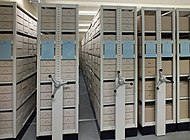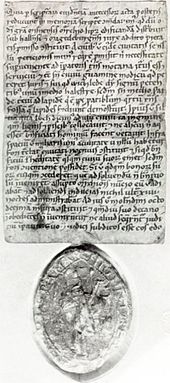Leipzig City Archives
The Leipzig City Archive documents the history of Leipzig with evidence since the Middle Ages in the form of documents, files, business books , newspapers and printed matter, maps and plans as well as photos and postcards. With its holdings, it is one of the most important municipal archives in Germany. His tasks also include keeping the city chronicle.
Location and facility
Since October 2019, the Leipzig City Archives have been located on the Old Exhibition Grounds in the converted former Soviet exhibition pavilion at Straße des 18. Oktober 42. The Soviet star is still shining above the building; it is a listed building . The head building and almost a fifth of the adjacent, flatter nave were used for the city archive.
In the center of the front building in the former entrance hall is the so-called research hall with 28 workstations, equipped with reading and re-enlargement devices as well as computer technology. A large mural near the gallery shows Leipzig's central location at the intersection of Via Regia and Via Imperii . The registration area is to the right of the research hall, and behind it the restoration workshop with a wet section and a dry area offers optimal conditions for the restorers. To the left of the research hall is the lecture hall, which, as the Wustmann hall, is reminiscent of the first director of the city archive, Gustav Wustmann . In the certificate hall opposite are cabinets from the early days of the archive. The office and work rooms of the archive staff are located on the outside of the building on the ground floor and on the upper floor. The magazine takes up the largest part of the house with 8200 m² of floor space. It offers space for around twenty kilometers of shelves for archive material (around 186,000 archive boxes) as well as almost 470 plan cabinets. This space will last until around 2030. There are plans for expansion until 2050.
The house has no active air conditioning. The passive air conditioning through double-shell walls and air buffers ensures that extreme temperature fluctuations are cushioned.
history
The first forerunner of the city archives can be seen in 1483 under the council chamber for the storage of documents, later called the aerarium. In 1721 the council administration had 15 departments called “parlors”, each with their own storage rooms (“additional chambers”). For 1819 to 1822 a reorganization of the now apparently central main archive by the town clerk Heimbach is reported.
From 1879 to 1881, parts of the holdings of the Council Archives were relocated to the basement of the Museum of Fine Arts on Augustusplatz and hereinafter referred to as Council Archives I. With the creation of the director's position for the archive and its occupation with the academic Gustav Wustmann on October 1, 1881, this date is considered to be the establishment of the city archive as a scientific institution. Wustmann was also the director of the Leipzig city library . This duplication of offices was retained until 1945. In 1886 the Ratsarchiv I was opened for general scientific use, whereby the reading room of the city library was available for visitors to inspect files.
With the incorporation of the Leipzig suburbs around the turn of the century, the archive had grown considerably. Therefore, in 1912, four closed holdings of the archive were moved to the newly built town hall , where the entire archive followed in 1924. In 1940 the name was changed from Ratsarchiv to Stadtarchiv. From 1933 onwards, a large proportion of the archive inquiries related to the Aryan evidence required during the Nazi era . The use of the archive for Jews and foreigners was severely restricted.
Despite severe bomb damage to Leipzig in World War II , the city archive hardly suffered any loss of inventory. In 1945, the personal union in the management of the city library and city archive was dissolved and Ernst Müller, who had been employed as archivist since 1926 and was primarily involved in the creation of the Leipzig house book, was entrusted exclusively with the management of the city archive.
A city chronicler was hired in 1960 to look after the city chronicle. The first inventory overview since the city archive was founded was made in 1968, and the first printed inventory was published in 2003. In 1987/1988 computing technology found its way into the city archive.
In connection with the reconstruction of the town hall complex, the archive moved to Torgauer Straße in the east of Leipzig in the Volkmarsdorf district in 1994 . Until 1992/93 the building belonged to GalvanoTechnik Leipzig GmbH, which emerged from VEB Galvanotechnik Leipzig after privatization in 1990 . The VEB was created through the nationalization of Langbein-Pfanhauser Werke , which has been based here since 1889 .
In the building, reconstructed for archival purposes, four floors and the basement were used by the archive, while a discounter was housed on the ground floor . In addition to 8,000 m² of storage space, the city archive also had a lecture and seminar room and two exhibition foyers. The reading room offered 36 workstations, eight reading and re-enlargement devices and two card tables. A modern mobile shelving system enabled the storage rooms to be used effectively. A bookbinding and restoration workshop was part of the archive.
Due to a lack of space, it was decided to move to Hall 12 of the old exhibition grounds. The foundation stone for the renovation was laid on November 28, 2016 and the opening at the new location on October 29, 2019.
Directors
- 1881–1910: Gustav Wustmann (1844–1910)
- 1911–1924: Ernst Kroker (1859–1927)
- 1925–1945: Johannes Hofmann (1888–1954)
- 1945–1959: Ernst Müller (1894–1972)
- 1959–1969: Manfred Unger (1930–2016)
- 1969–1972: various, only briefly
- 1972–1983: Horst Thieme (1931–1986)
- 1983–1987: Waldemar Künn
- 1987–2018: Beate Berger
- since 2019: Michael Ruprecht
Stocks
The archive's holdings are divided into municipal and non- municipal archival material. The former contains documents and files of the city administration and municipal institutions and companies. The more than 4,000 documents cover the time from the Leipzig city letter from approx. 1165 as the founding document of the city to 1854. Files and business books cover 10,000 running meters .
Non-municipal archives relate to non-urban Leipzig businesses, societies and associations as well as bequests. Then there is the large area of collections. The photo collection contains over 125,000 photos and postcards on architecture, economy, education, culture and municipal affairs in the city of Leipzig from around 1870 to the present, and the map collection contains more than 75,000 maps and plans from around 1530 (city fortifications) to the present .
The newspaper collection with press products from 1730 on includes daily newspapers and periodically, e.g. B. Weekly newspapers. The majority of the over 50 titles were published in Leipzig. The official publications as a further part of the collection contain statutes, ordinances and official gazettes, beginning in 1482.
An overview of the entire holdings of the Leipzig City Archives contains a special volume from the Leipzig Calendar series .
The archive's library comprises around 8,000 volumes, primarily on Leipzig city history, Saxon regional history and archive and auxiliary sciences.
tasks
The main task of the archive is to maintain the archive material. This includes the maintenance of the inventory, the addition of the inventory, the development of the inventory and its evaluation. Preservation consists primarily in the removal of damage to the substance of the archive material, for example through paper disintegration . The Leipzig City Archives mainly entrusts external companies with the restoration of damaged archive materials. More than 90% of the financial expenditures for the maintenance of the stock went to them in 2005. Existing additions are mainly made through cooperation with municipal institutions and own companies, but also through donations and purchases. The indexing of the archive material records the essential information content of the archive material and ensures optimal access for the user through appropriate organization and directories. The archive material is evaluated either by the user directly in the reading room or by the archive answering his written inquiries.
Another area of responsibility is public relations. The archive organizes lectures, guided tours and seminars and designs exhibitions. The publication of the Leipzig calendar series is also part of it. The city archive also keeps the daily chronicle of the city of Leipzig from 1945 to the present, which has been available in digital form since 1989 and can be viewed in the reading room or on the archive's website. Since 1995, the publication series of the Leipzig City Archives Leipzig Calendar has been published every two years, supplemented by special volumes .
The city archive maintains a lively cooperation with numerous Leipzig institutions, such as the Leipzig History Association , with which it organizes annual conferences on various topics of city history, the Pro Leipzig association for the publication of district studies and the Leipzig museums for exhibition designs.
Web links
- Website of the Leipzig City Archives. Retrieved April 19, 2016 .
- Holdings of the Leipzig City Archives in Archivportal-D
- 125 years of the city archive. (PDF) In: Website of the City of Leipzig. Retrieved April 19, 2016 .
- Start of construction at the Alte Messe: the Soviet pavilion will be Leipzig's new city archive. In: LVZ -Online. Retrieved June 29, 2016 .
Individual evidence
- ↑ Leipzig City Archives. In: Website of the City of Leipzig - Archives in Leipzig. Retrieved April 19, 2016 .
- ↑ Saxon list of monuments ID no. 09306657
- ↑ a b Leipzig's new treasury . In: Leipziger Volkszeitung . October 30, 2019, p. 15 .
- ↑ Ernst Müller: The house names of old Leipzig . (Writings of the Association for the History of Leipzig, Volume 15). Leipzig 1931, reprint Ferdinand Hirt 1990, ISBN 3-7470-0001-0
- ↑ New domicile planned for the city archive in Hall 12 of the Old Fair. In: Website of the city of Leipzig. Retrieved April 19, 2016 .
- ^ New director for the Leipzig city archive. In: Website of the city of Leipzig. Retrieved November 2, 2019 .
- ↑ Overview of the holdings of the Leipzig City Archives . Special volume Leipziger Kalender 2002/1, Leipziger Universitätsverlag, 2002 (online) ( Memento from April 25, 2016 in the Internet Archive )
- ↑ 125 years city archive , p. 26
Coordinates: 51 ° 20 ′ 49 ″ N , 12 ° 25 ′ 10 ″ E






